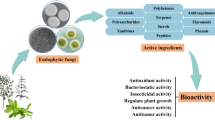Abstract
The heartwood of the tropical tree Calophyllum brasiliensis is known to be highly resistant to fungi and termites. To determine whether resistance to wood-rotting fungi could be caused by bioactive secondary metabolites, a chemical and biological study was carried out. Hexane, acetone, methanol, and water extracts were prepared. The yield of the extracts ranged from 0.04% (hexane) to 4.81% (acetone). Methanol, acetone, and water extracts (5 mg/ml = 0.5%) inhibited the mycelial growth of the brown rot fungus Postia placenta by 83%, 59%, and 21%, respectively. Chromatographic separation of the acetone and methanol extracts afforded five prenylated xanthones: 6-desoxyjacareubin (I), 1,5-dihydroxy-2-(3,3-dimethylallyl)-3-methoxy-xanthone (II), jacareubin (III) and 1,3,5-trihydroxy-2-(3,3-dimethylallyl)-xanthone (IV) and 1,3,5,6-tetrahydroxy-2-(3,3-dimethylallyl)-xanthone (V). Xanthones III, IV, and especially V, were the most abundant constituents of both extracts and inhibited at 0.25 mg/ml the mycelial growth of P. placenta. Inhibitory activity ranged from 55.5% (V) to 68.8% (III and IV mixture). Acetylation of xanthones did not induce a sharp change in the extent of fungistasis compared with parent compounds. The above results suggest that C. brasiliensis xanthones actually play a defensive role against wood decay fungi.
Similar content being viewed by others
REFERENCES
AMPOFO, S. A., and WATERMAN, R. G. 1986. Xanthones and neoflavonoids from two Asian species of Calophyllum. Phytochemistry 25:2611–2620
BÁRCENAS-PAZOS, M. G. 1995. Características tecnológicas de veinte especies maderables de la Selva Lacandona. Madera y Bosques (México) 1:9–38.
CARTER, F. L., and CAMARGO, C. R. R. 1983. Testing antitermitic properties of Brazilian woods and their extracts. Wood Fiber Sci. 15:350–357.
CHUDNOFF, M. 1994. Tropical Timbers of the World. Agriculture Handbook No. 607. United States Department of Agriculture. Washington, DC, 466 pp.
DÉON, G. 1983. Les composés flavoniques du dabema et leur role dans la résistance de ce bois a la pourriture. Cahiers Scientifiques du Centre Technique Forestier Tropical, Supplément au 6. Nogent su Mer, France, 16 pp.
GÓMEZ-GARIBAY, F., REYES-CHILPA, R., QUIJANO, L., Calderon-Pardo, J. S., and RIOS-CASTILLO, T. 1990. Methoxy furan auronols with fungistactic activity from Lonchocarpus castilloi. Phytochemistry 29:459–463.
GUNASEKERA, S. P., JAYATILAKE, G. S., SELLIAH, S. S. and SULTANBAWA, M.U.S. 1977. Chemical investigation of Ceylanose plants. Part 27. Extractives of Calophyllum cuneifolium Thw. and Calophyllum soulattri Burm. F. (Guttiferae). J. Chem Soc. Perkin I 1977:1505–1511.
JACKSON, B., LOCKSLEY, H. D., and SCHEINMANN, F. 1966. Extractives from Guttiferae. Part I. Extractives of Calophyllum sclerophyllum Vesq. J. Chem. Soc. (C) 1966:178–181.
JACKSON, B., LOCKSLEY, H. D., and SCHEINMANN, F. 1967. Extractives from Guttiferae. Part. VII. The isolation and structure of seven xanthones from Calophyllum scriblitifolium Henderson and Wyatt-Smith. J. Chem. Soc. C 1967:2500–2507.
JACKSON, B., LOCKSLEY, H. D., and SCHEINMANN, F. 1969. The isolation of 6-desoxyjacareubin, 2-(3,3-dimethylallyl)-1,3,5,6-tetrahydroxyxanthone and jacareubin from Calophyllum inophyllum. Phytochemistry 8:927–929.
KIRK, T. K., 1983. Degradation and conversion of lignocelluloses, in J. E. Smith, D. R. Berry, and B. Kristiansen (eds.). Filamentous Fungi, Vol. 4, Fungal Technology. Edward Arnold, London, 122 pp.
MC DANIEL, C. A. 1992. Major antitermitic components of the heartwood of southern catalpa. J. Chem. Ecol. 18:359–369.
MINAMI, H., KINOSHITA, M., FUKUYAMA, Y., KODAMA, M., YOSHIZAWA, T., SIGIURA, M., NAK AGAWA, K., and TAGO, H. 1994. Antioxidant xanthones from Garcinia subelliptica. Phytochemistry 36:501–506.
MINAMI, H., TAKAHASHI, E., FUKUYAMA, Y., KODAMA, M., YOSHIZAWA, T., and NAKAGAWA, K. 1995. Novel xanthones with superoxide scavenging activity from Garcinia subelliptica. Chem. Pharmacol. Bull. 43:347–349.
ORTEGA-ESCALONA, F., CASTILLO-MORALES, I., and CARMONA-VALDOVINOS, T. 1991. Anatomía de la Madera de Veintiseis Especies de la Selva Lacandona, Chiapas. Angiospermas Arboreas de México No.3. La Madera y su Uso 26. Instituto de Ecología A.C. and Universidad Autónoma Metropolitana, México, 200 pp.
PATIL, A. D., FREYER, A. J., EGGLESTON, D. S., HALTIWANGER, R. C., BEAN, M. F., TAYLOR, P. B., CARANFA, M. J., BREEN, A. L., BARTUS, H. R., JOHNSON, R. K., HERTZBERG, R. P., and WESTLEY, J. W. 1993. The inophyllums, novel inhibitors of HIV-1 reverse transcriptase isolated from the Malaysian tree, Calophyllum inophyllum Linn. J. Med. Chem. 36:(26) 4131–4138.
PINTO, D. G., FUZZATI, N., PAZMINO, X. C., and HOSTETTMANN, K. 1994. Xanthone and antifungal constituents from Monnina obtusifolia. Phytochemistry 37:875–878.
REYES-CHILPA, R., PÉREZ-MORALES, V., andDEL ANGEL-BLANCO, S. 1987. Influencia de los extractivos en la resistencia natural de seis maderas tropicales al hongo de pudrición morena Lenzites trabea. Biotica (Mexico) 12:7–13.
REYES-CHILPA, R., VIVEROS-RODRÍGUEZ, N., GÓMEZ-GARIBAY, F., and ALAVEZ-SOLANO, D. 1995. Antitermitic activity of Lonchocarpus castilloi flavonoids and heartwood extracts. J. Chem. Ecol. 21:455–463.
REYES-CHILPA, R., QUIROZ-VÁSQUEZ, R. I., JÍMENEZ-ESTRADA, M., NAVARRO-OCAÑA, A., and CASSANI-HERNÁNDEZ, J. 1997. Antifungal activity of selected plant secondary metabolites against Coriolus versicolor. J. Trop. For. Prod. In press.
ROCHA, L., MARSTON, A., KAPLAN, M. A. C., STOEKLI-EVANS, H., THULL, U., TESTA, B., and HOSTETMANN, K. 1994. An antifungal γ-pyrone and xanthones with monoamine oxidase inhibitory activity from Hypericum brasiliense. Phytochemistry 36(6):1381–1385.
RODRIGUEZ, S., WOLFENDER, J. L., HAKIZAMUNGU, E., and HOSTETTMANN, K. 1995. An antifungal naphthoquinone, xanthones and secoiridoids from Swertia calycina. Planta Med. 61:362–364.
SCHEFFRAHN, R. H. 1991. Allelochemical resistance of wood to termites. Sociobiology 19:257–281.
SCHEFFER, T. C., and COWLING, E. B. 1966. Natural resistance of wood to microbial deterioration. Ann. Rev. Phytopathol. 4:147–170.
SCHULTZ, T. P., HARMS, W. B., FISHER, T. H., MC MURTREY, K. D., MINN, J., and NICHOLAS, D. D. 1995. Durability of angiosperm heartwood: The importance of extractives. Holzforschung 49:29–34.
SEN, A. K., SARKAR, K. K., MAJUMDER, P. C., and BASEERJI, N. 1981. Minor xanthones of Garcinia mangosta. Phytochemistry 20:183–185.
TORELLI, N. 1982. Estudio promocional de 43 especies forestales tropicales mexicanas. Reporte Técnico Programa de Cooperación Científica y Técnica México-Yugoslavia. Secretaria de Agricultura y Recursos Hidraúlicos. México.
Author information
Authors and Affiliations
Additional information
Contribution 1264 from Instituto de Química, UNAM. Presented in part at the 22nd International Symposium on Natural Products Chemistry, Mexico City, May 6–7, 1996
Rights and permissions
About this article
Cite this article
Reyes-Chilpa, R., Jimenez-Estrada, M. & Estrada-Muñiz, E. Antifungal Xanthones from Calophyllum brasiliensis Heartwood. J Chem Ecol 23, 1901–1911 (1997). https://doi.org/10.1023/B:JOEC.0000006459.88330.61
Issue Date:
DOI: https://doi.org/10.1023/B:JOEC.0000006459.88330.61




